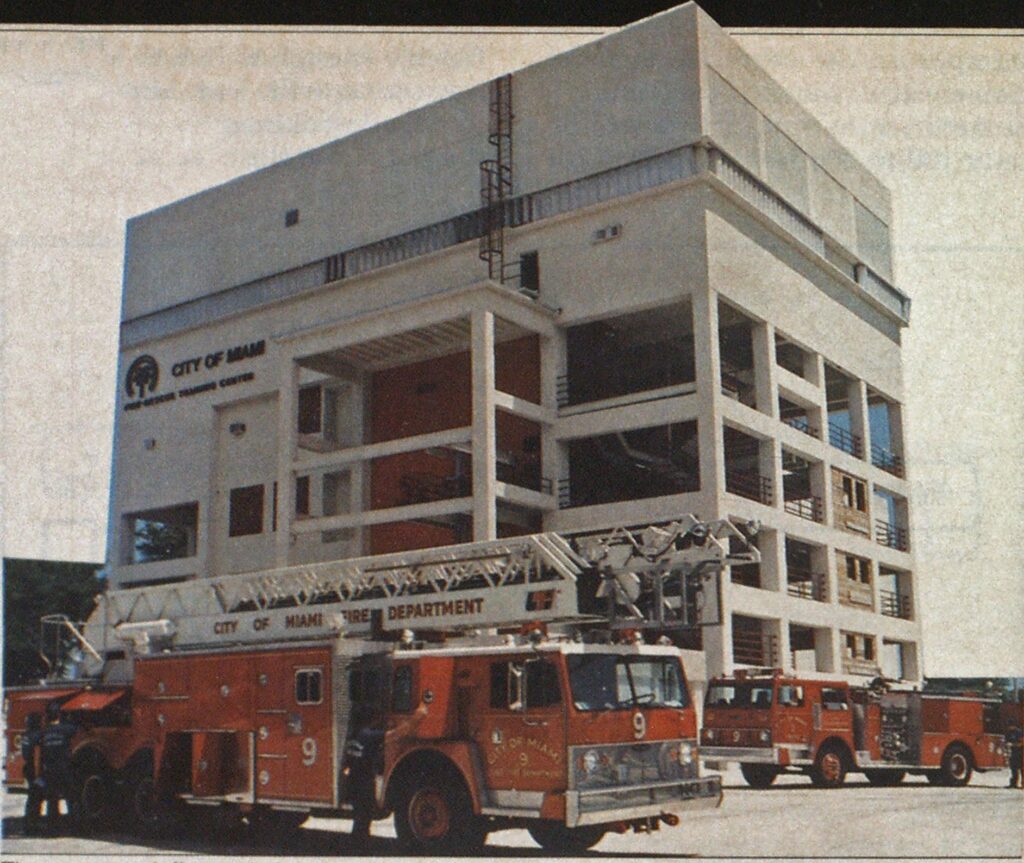
Trash to Training
FEATURES
TRAINING
The fire service is known for adapting equipment that was originally designed for another profession to fit its own particular needs (e.g., self-contained breathing apparatus was initially developed for scuba divers, carabiners and harnesses were made for mountain climbers, etc.).
The City of Miami, FL, Fire Department took this tradition of versatility one step further when it constructed a modern fire/rescue training center on what was once a trash disposal site.
The site had been a rubbish disposal area since the turn of the century. At that time, smoke drifted harmlessly over uninhabited woods and prairies.
In 1926, the area began to be populated, and when the first hand-fired incinerator was built, soot fires in the stack sent up sparks that set roof fires on nearby houses.
In 1960, the existing trash disposal building was constructed to the state of the art, and the 200-foot stack washed the smoke discharge as it passed through a spray chamber before it was released. The area continued to grow, and from the beginning, the new incinerator generated complaints because of the foul odor, fallout, and soot. In the 1970s, the nationwide environmental movement brought a great deal of focus onto pollution control, and neighborhood activists were successful in closing the incinerator in January 1974. As a symbolic gesture, the 200-foot stack was demolished March 24, 1974, and bricks from the stack were given as mementos.
The City of Miami Fire Department began searching for property in 1977 to develop a new fire/rescue training center to replace the old five-story tower that contained only one classroom. Because of limited space, we were required to use four training sites around the city that, on occasion, required transport between facilities and loss of classroom time.

Photo courtesy of Miami Fire Department
A bond program was approved in 1976 by the city’s residents. Funds were now available for a new, modern facility to train firefighters, fire officers, paramedics, inspectors, and fire dispatchers.
We felt that a threeto five-acre site was necessary. We also felt that it was important to be near the inner-city, even though open burning would not be allowed. All sites evaluated proved to be too costly or unavailable for our specific purposes. We met with the city manager to advise him of our problem and he suggested that we evaluate the abandoned incinerator site. This site was approximately four acres and the building had an interior volume of over 60,000 cubic feet.

Photo courtesy of Miami Fire Department
Continued on page 64
Continued from page 62
We hired an architect to develop a feasibility study. He was to address questions such as:
- Could the building be retrofitted as a fire/rescue training facility?
- Could the building be demolished and a new facility constructed at less cost?
The answer to both questions was yes.
There were some unique features to the incinerator: a ramp leading to the tipping room where the garbage was dumped would create an interesting, aesthetically-pleasing entrance to this building; large, open spaces on the ground floor were easily converted into an apparatus room; and a 30-foot deep pit with a sump and piping for drainage could be converted into a rescue diving pool. The 87-foot high building, which is one of the tallest buildings in the area, proved to be an excellent radio antenna site for the south end of the city.
Getting public approval for the necessary zoning changes was difficult. Even though the site, which had become a neighborhood nuisance, was flanked on the east and west by public schools, there was some organized neighborhood resistance. There was an existing plan to utilize the building as a cultural center.
We held several meetings with the neighbors and conducted open public hearings before the zoning board of the City of Miami to answer all questions and to try to dispel rumors that fire trucks would be racing up and down the streets with red lights and sirens screaming, while fire and smoke belched from every window of the building.
Ultimately, the city commission approved re-zoning, and construction of the new facility began July 8, 1981.
The vast size of the interior allowed the creation of six levels into which we incorporated many special features:
Fire museum.
- 100-seat auditorium.
- TV production studio.
- Emergency generator.
- Fireman service elevator.
- Fire alarm system.
- Smoke detection system.
- Emergency dispatcher training (computers).
- Air mask training.
- One-thousand two-hundredsquare-foot maze.
- Human performance lab (fully equipped strength facility).
- Foreground tactics simulator.
- Emergency medical service open learning center.
- Rescue diving pool with solar water heating.
- Two pumpers, a 100-foot aerial, and a paramedic unit for fire recruit training.
This modern $3.2-million facility provides training for firefighters of all ranks, recruits through command officers.


